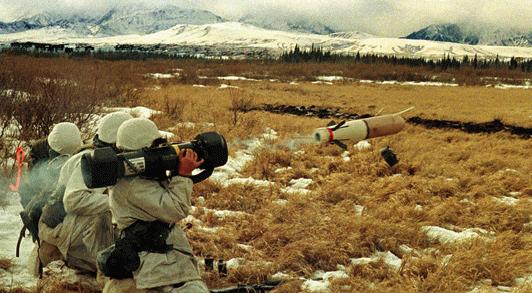Lockheed Martin FGM-172 SRAW
The SRAW (Short-Range Assault Weapon) program was begun by the U.S Marine Corps in 1987 as a replacement for existing unguided anti-armour rockets and grenades like the M72 LAW (Light Anti-Armour Weapon) and the M136 AT4. Between February 1990 and mid-1993, a demonstration/validation phase was conducted by several competing companies, with the first test firings occuring in 1991. In July 1994, the Predator design of Loral (now Lockheed Martin) was selected for the EMD (Engineering and Manufacturing Development) phase. It was not before 2006 that the official designation FGM-172A was assigned to the missile (before that, it was formally known as SRAW MK 40 MOD 0).
The FGM-172A is a small solid-fueled rocket powered missile, which is manually aimed and fired from an expendable shoulder launcher. The complete ready-to-fire system including missile and launcher weighs only 9.7 kg (21.4 lb). The motor is a "soft-launch" rocket with a low initial thrust, so that the weapon can be safely fired from enclosed positions. The SRAW is a fire-and-forget missile which can be used at ranges between 17 m (55 ft) and 600 m (2000 ft) against stationary and moving targets. During aiming, the SRAW's inertial reference autopilot detects the angular motion of the target, and during flight the autopilot directs the missile to a position above the predicted target location. The FGM-172A is armed with a downward-firing top-attack warhead (very similar to the BGM-71F TOW 2B), which is activated by a dual-sensor (laser & magnetic) fuze in the missile's nose.
 |
| Photo: Lockheed Martin |
| FGM-172A |
EMD Phase I (Risk Reduction) was completed in March 1998, and was followed by Phase II (System Evaluation). In January 2002, Lockheed Martin was awarded the first LRIP (Low-Rate Initial Production) contract for SRAW, followed by a second one in January 2003. During EMD, a total of about 230 Predator missiles were built, and the two LRIP contracts cover the production of 730 rounds. SRAW was to be a low-cost complement to the larger and more sophisticated FGM-148 Javelin anti-armour missile, but further procurement after LRIP has been cancelled in 2003. In 2004, Lockheed Martin received a contract to refit all remaining SRAW rounds to the FGM-172B SRAW-MPV (Multi-Purpose Variant) configuration with a new multi-purpose blast-fragmentation warhead. This will convert the missile from an anti-armour to a direct-fire urban assault weapon, which better fulfills the needs of the USMC.
The U.S. Army evaluated a derivative of the Predator SRAW with a multipurpose warhead for its MPIM (Multipurpose Individual Munition) requirement. A variant named Kestrel, with a direct-attack warhead, was unsuccessfully entered in the UK's NLAW (Next Generation Light Anti-Armour) competition.
Specifications
Note: Data given by several sources show slight variations. Figures given below may therefore be inaccurate!
Data for FGM-172A (missile without launcher):
| Length | 70.5 cm (27.8 in) |
| Diameter | 14 cm (5.5 in) |
| Weight | 6.4 kg (14.1 lb) |
| Speed | 900 km/h (560 mph) |
| Range | 600 m (2000 ft) |
| Propulsion | Dual-thrust solid-fueled rocket |
| Warhead | Downward-firing EFP (Explosive Formed Projectile) |
Main Sources
[1] Hajime Ozu: "Missile 2000 - Reference Guide to World Missile Systems", Shinkigensha, 2000
[2] Lockheed Martin Missiles and Fire Control Website
[3] GlobalSecurity.org Website
[4] Army Technology Website:
"Predator/Kestrel Light Anti-Armour Missile",
Net Resources International Ltd.
Back to Current Designations Of U.S. Unmanned Military Aerospace Vehicles
Back to Directory of U.S. Military Rockets and Missiles
Last Updated: 27 September 2006